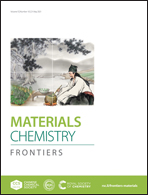A topochemically constructed flexible heterogeneous vanadium-based electrocatalyst for boosted conversion kinetics of polysulfides in Li–S batteries†
Abstract
Lithium–sulfur batteries (LSBs) are considered as one of the most promising next-generation high-energy rechargeable batteries due to their ultrahigh energy density and low cost, however, their practical application has been severely hindered due to the rigorous shuttle effect of soluble polysulfides and sluggish reaction kinetics. Here, a novel flexible 3D nitrogen-doped graphene supported V2O3/VN heterogeneous host was constructed by a facile topochemical nitridation strategy. Such unique architecture endowed the V2O3 with strong adsorption activity and the highly conductive VN with superior catalytic capability, synergistically promotes the redox kinetics and effectively restrains the shuttle effect of polysulfides. Impressively, the designed V2O3@VN-20 electrode exhibited a high reversible capacity of 1130 mA h g−1 and 980 mA h g−1 at 1C and 2C respectively, and maintained long-term cyclability with a low capacity decay of 0.1% per cycle after 300 cycles at 5C. More importantly, the heterostructured electrode still retained a high capacity of 862 mA h g−1 with a high sulfur loading of 5 mg cm−2 after 100 cycles at 0.5C. Our work might provide a general approach for guiding the rational design of heterostructured materials with multifunctionality towards high-energy flexible Li–S batteries.

- This article is part of the themed collection: Energy storage with rechargeable Li batteries and beyond


 Please wait while we load your content...
Please wait while we load your content...